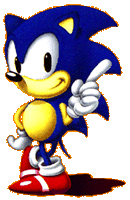


Sega and Motorola just announced its joint venture of games-on-demand for Motorola's new line of phones to be released in the spring of 2001. Today, Sega released its current list of games that the company is working on at the JavaOne conference in San Francisco.The planned games are:
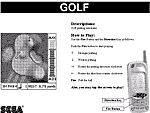
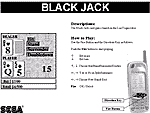
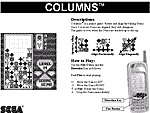
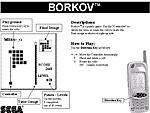
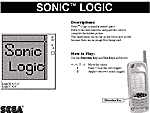
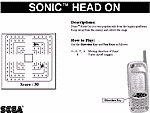
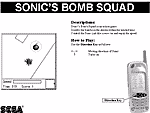
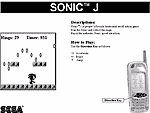
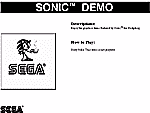

As many of you already know, soon a new Sonic cartoon series called "Sonic Underground" will be aired. Alas, SEGA still keeps most of it under wraps, but I'll give you an overview of the info that has already leaked out... and more. Since everything is still unofficial, of course the final version may differ from what I tell you here.
The first season of the series will have 40 episodes, with animation done by DiC France. Sonic's voice is again done by the all-famous Jaleel "Urkel" White, the same person who did it in previous Sonic series. The show is supposed to be a mix between the syndicated and the SatAM cartoon, although with a completely new setup. So far there seem to be NO references to the original SatAM cartoon. This means no Sally, no Bunnie, no Rotor, no Antoine, no Dulcy, not even Tails! Apart from Sonic and Robotnik, no other of the established SEGA characters seem to be in.
Personally, I'm not very satisfied with this new concept. Although it does have potential when seen as a stand-alone, I simply can't bring myself to forget the original SatAM cartoon, and how much I loved it.
The SatAM series already had an establised set of nicely-developed characters, a huge fan following, and even a comic book based on it. For years we all hoped for a renewal, but SEGA deliberately ignored all this and decided to start over. It would have been easy for them to incorporate the 'classic' continuity into the new one, but they didn't even try. On the other hand, what did we expect of a company like SEGA, which always supported only the crappy "Adventures of Sonic the Hedgehog" series instead of the superior SatAM?
US residents who would like to find out if the series is shown in their area, please check out
http://www.tvguide.comGo to the listings, enter your ZIP code, and then search for the show.
Source: Reuters Limited / Variety

The Great Legend"One future day, the planet Mobius will be ruled in peace by the Council of Four, by Queen Aleena and her three children. Sheriff Robotnik will be defeated, and freedom will be won for all citizens."
When Robotnik learned that the Queen had given birth to triplets, he ordered his SWATbots to capture them, so the prophecy could never be fulfilled. But the Queen sent her children into hiding in different parts of the planet, while she herself left her home and from then on wandered around Mobius.
Years later, when Sonic had already become a Freedom Fighter, he learned about his siblings, and from then on didn't rest until he had found them.
The band "Sonic Underground" is formed by three members. Sonic, who plays a guitar, his brother Manic, who plays the drums, and their sister Sonia, who plays the keyboard.
Together they travel around Mobius, always in hope to one day find their mother, while constantly pursued by Robotnik's forces. Whereever they go, they try to help the troubled citizens they meet on their quest, and with their music they spread the spirit of freedom in the minds of the oppressed Mobians.
Sonic
Sonic is the usual high-speed hero with fast moves and cool talking. He only fears water, since he can't swim. His instrument is the guitar.Manic
Manic looks a lot like a buzzcut version of Sonic. He often has his head in the clouds and is sometimes so caught by his own beat that he forgets what happens around him, which can bring him into dangerous situations from which Sonic and Sonia then have to rescue him. His instrument are a set of drums.Sonia
Used to take care of herself before she joined the band, Sonia is quite an independent character, and almost as eager to join any action that comes her way as Sonic is. Her instrument is a portable keyboard synthesizer.Robotnik
As always, Robotnik is the ultimate villain of the series, this time with the difference that he has given himself the title "Sheriff". To finally become Rightful Ruler of Mobius, he is obsessed by the idea to find Queen Aleena and marry her.Sleet and Dingo
Sleet and Dingo are two Bounty Hunters working for Robotnik (a wolf and a jackal). Both are experts in camouflage, and have the ability to morph into any object they want, although there will still be some characteristic of their usual appearence (think "Little Wizards", if anyone remembers that cartoon).
Source: Sonic Series Bible by Bruce Shelly & Anne Baumgarten

Sega Partners With Microsoft, Hitachi, NEC, Videologic and Yamaha on Powerful New Console
Sega(R) of America's parent company, Sega Enterprises, Ltd., revealed its new ultimate video game machine with the power to outperform all in-home gaming platforms and most arcade systems.
That power, driven by Sega's revolutionary system design, will deliver gaming experiences previously impossible on any home entertainment platform. A super console called Dreamcast (TM).
Dream cast can also describe Sega's platform partners -- all global leaders in business and technology. Sega worked closely with Microsoft, Hitachi, NEC and Videologic, and Yamaha to customize each partner's Dreamcast contribution for unmatched 3D gaming performance.
With 128-bit performance from a reduced instruction set computing (RISC) central processor, an independent 3D graphics engine and a dedicated 3D sound chip, Dreamcast achieves a level of total system performance unrivaled by any consumer entertainment product. Dreamcast is also the first video game console to offer standard networking features for multiplayer gaming, bringing the best features of console, PC and online gaming together on one system.
"Dreamcast is Sega's bridge to worldwide market leadership for the 21st century," said Bernard Stolar, president and chief operating officer, Sega of America. "The Sega you see today is driven by two important goals: delivering the best new gaming experiences this industry has ever seen, and winning back the No. 1 position in the console category. We'll do whatever it takes to get there."
Dreamcast was designed to appeal to the hard core gamer, as well as the casual gamer and people who have never enjoyed interactive entertainment. Polygon counts topping three million per second leave players staring at the whites of their opponent's blood-shot eyes.
A dedicated real-time 3D sound processor surrounds players with 64 channels of music, voices and gameplay sound effects at a quality rivaling professional audio equipment. Dreamcast's online capabilities will unite Sega fans around the globe with a range of intense action gaming that only a video game console can offer.
Dreamcast can display revolutionary new types of realistic and engrossing 3D graphics. Human movements, fog, water effects, light and shading appear ultra-realistic. With this level of graphic performance, effects such as the passage of time from day to night can be portrayed in real-time.
Another revolutionary feature of Dreamcast is the Visual Memory Unit (VMU), which is a memory card and the world's smallest portable game card with built-in LCD screen. Plugged into the Dreamcast controller, the LCD screen lets players set up secret moves against their opponents, such as killer plays in sports games, for which the defensive player will not be able to plan, thus adding an even more realistic feel to the game.
Pull out the VMU card and it becomes a portable electronic game card no bigger than a business card. In addition, users will be able to save game features, such as user-created special players or teams, and share them with friends simply by linking two VMU cards together.
In designing Dreamcast, Sega accomplished its two key design goals: 1) a seamless integration of high-performance components, each optimized for a specific game processing and display task, and 2) a scaleable system architecture to take advantage of future technical enhancements and new gaming concepts hidden in the minds of the industry's most creative game developers.
Dimensions: 7 7/16" x 7 11/16" x 3" Weight: 4.4 lbs Main CPU: Hitachi SH-4 Engine with 128 bit graphics engine Running Speed: 200 MHZ, 360 MIPS, 1.4 GFLOPS Graphics CPU: NEC PowerVR2 running over 3 million polygons per second (pps) Hardware Effects: Real time lighting, triangular/quad engine, bump mapping, fog effects, specular highlighting, super sampling anti-aliasing, texture filtering, alpha blending, ARGB gouraud shading, and much more Sound Engine: Yamaha super intelligent sound processor (64 channel ADPCM) RAM: 16 MB of RAM (64-megabit SD RAM x 2) of main system RAM, 8 MB VRAM, and 2 MB RAM just for audio Modem: V34 (33.6 Kbps), V42 and MNP5 full support Operating System: Customized Microsoft Windows CE or SEGA's custom OS Storage Medium: 12x CD-ROM drive featuring 1 GB capacity Controller: Directional control: Analog stick or digital pad, 4 color coded buttons, 2 trigger buttons, and start button Clock: Clock Function Included VSM: up to 2 pda's can be inserted in each controller Release Date: Late '98 (Japan)
Late '99 (U.S.)Price: Approx $ 250
Microsoft
Microsoft will provide a customized version of its Windows CE operating system with DirectX services that has been optimized for console-style gaming. Windows CE provides Dreamcast developers a flexible, versatile development environment supported by Microsoft Visual C++ 5.0 that makes title development more efficient. Windows CE with DirectX has been hand-tuned to be small and fast to provide superior performance specifically targeted at the Sega Dreamcast hardware architecture, giving developers the confidence that software developed for Dreamcast will take full advantage of every hardware capability in the system.Hitachi
The central processor in Dreamcast is the video game-customized Hitachi SH4 reduced instruction set chip (RISC). Sega and Hitachi retooled the chip to enhance its floating point operations capabilities -- the key ingredient for high-output 3D gaming applications. The Dreamcast processor can perform floating point operations four times faster than the Pentium II chip.NEC
The muscle behind Dreamcast's high-end graphics engine is a custom-designed version of the PowerVR Second-generation technology developed jointly by NEC and Videologic. With a peak performance of over 3 million polygons per second and customized anti-aliasing technology, the PowerVR Second-generation technology chip in Dreamcast outperforms all other graphics chips today or proposed for use in upcoming PCs. NEC has a proven track record in the chip industry and is a global leader with expertise in chip design and fabrication.Yamaha
Yamaha is contributing a dedicated, real-time 3D audio chip with more power than some next generation consoles offer in total. Sega also worked with Yamaha to develop a high-speed CD-ROM drive for the platform, which speeds up access time and allows for much bigger games and larger playing fields.Sega of America is the arm of Tokyo, Japan-based Sega Enterprises, Ltd. responsible for the development, marketing and distribution of Sega videogame systems and videogames in the Americas. Sega Enterprises, Ltd. is a nearly $3.0 billion company recognized as the industry leader in interactive digital entertainment media, and is the only company that offers interactive entertainment experiences both inside and outside the home. Sega of America's World Wide Web site is located at http://www.sega.com .
Sources: SEGA Press Releases, Game Magazines

Sonic Jam!
Sonic Jam is a four-in-one Saturn compilation of the first four Sonic games for the Genesis/Mega Drive. It includes the complete versions of Sonic 1, Sonic 2, Sonic 3, and Sonic & Knuckles, with all the lock-on features. Although all the data is read from a CD instead of a cardridge ROM, there is almost no loading time between each level. All of the original music was included with each game. There were a few sound effect changes, but only minor.
One nice feature was that Sonic's spindash (fron Sonic 2) can now be used in Sonic 1 too. They even included the original game manuals from each game on the disk, both American and Japanese.
When you start the "Sonic World" level, you get a 3D version of Sonic gameplay, whick is really a teaser considering that that's what everyone wanted a 32-bit version to be. You can collect rings, and jump platforms, and even hitch a ride on the flying tails. However, all this is just something to pass the time as you make your way to the other Sonic Jam features: The Sonic Movie Theater, the Sonic Museum, the Sonic Art Gallery, and famous Sonic Sounds.
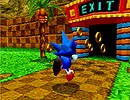
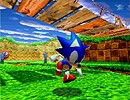
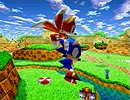
The Sonic Museum displays a track record of Sonic's life from the very beginning, starting from his announcement in 1990 during a tour of the Japanese band "Dreams Come True". It shows all his games and their covers (on all three sides of the oceans), even including the unknown ones like "Tails Air Patrol" for Game Gear, as well as screen-shots of a few of them.The video clips that you can watch in the Sonic Movie Theater are:
- The Opening and Ending from the Sonic CD game for SEGA CD, with the original Japanese soundtrack "Sonic, You Can Do Anything" and "Cosmic Eternity (Believe In Yourself)"
- A commercial for the Sonic Anime OVAs (Original Video Animation)
- A short cartoon from the American series
- Clip from "Sonic Ride". This FMV sequence was going to be a ride in Sega's Virtual World Simulators, but has been cancelled.
- Two Japanese commercials for Sonic the Hedgehog 1
- Two Japanese commercials for Sonic the Hedgehog 2
- Japanese commercial for Sonic the Hedgehog 3, although more in the "American SEGA" style
- Japanese commercial for Sonic Spinball
- Japanese commercial for Sonic CD (SEGA CD)
- Japanese commercial for Sonic Chaos (Game Gear)
- Japanese commercial for Sonic Triple Trouble (Game Gear)
- Japanese commercial for Sonic Drift (Game Gear). This game was not sold in Amercia, although Sonic Drift 2 was.
Sources: John W. Johnston (ab360@rgfn.epcc.edu) / Christopher C. Currens (fuzzbuzz1@juno.com) / Kulock "Tango" (eggleton@iwaynet.net)
Sonic R - the Sonic racing game
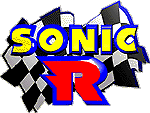
Sonic R is a Sonic racing game for the Saturn. It's being developed by the Sonic Team and programmed by Travellers Tales (who also programmed Sonic 3D Blast).
The game features four basic tracks and one hidden one. The basic tracks are Resort Island (the classic tropical paradise Zone), Regal Ruin, Radical City (the classic futuristic city-at-night Zone) and Reactive Factory (the classic Robotnik factory Zone). The hidden track is called Radiant Emerald and is run within a Chaos Emerald.
There are also extras like electro-shields that attract rings, or speedups and special sneakers to make you faster. You can eighter stay 'on track' or search for 'shortcuts' to save time. You can even run back, although that's not wise, because every second counts.
Somewhere on the track are closed doors that you can open when you carry a certain amount of rings with you, and behind it is a Chaos Emerald (one in the first track, two in each of the other three tracks). You have to get an emerald and make the first place in the race too, or you will loose it again.
Once you've collected all seven Chaos Emeralds, Sonic transforms into Super Sonic. He's got more speed and a higher jump than standard Sonic, and he can glide over water.
There are nine characters total in the game. Four come as default, and the rest are secret. The four normal characters are Sonic, who is the fastest (albeit with slippery control); Tails, who can fly short distances and is the all-round best without too many strengths or weaknesses; Knuckles, who holds turns very well; and Amy, who rides in a small car that has excellent control and acceleration, but lacks in the speed department.

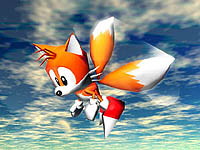
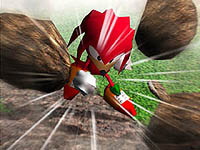

The first secret character is Robotnik, of course, who becomes playable after beating all five courses (including the secret one, Radiant Emerald) in first place. To obtain the others, you must find & collect all 5 Sonic Tokens hidden within each level, then place first, second, or third. Then you must beat the secret character in a race. Beat him, and he becomes playable.
The hidden racer for the Resort Island Zone is Metal Sonic. He's the fastest racer in the game (even faster than Super Sonic), but presumably has the worst control. He can jump higher than anyone else, though.
The hidden racer for the Radical City Zone is Metal Tails. Metal Tails actually looks like a Tails plush doll with a zipper down its back and a weird red diamond-thingie dangling out of his head. He has excellent acceleration, and can fly equally as well over all terrain, although he is a bit slow. He's also got a weird "float" move.
The hidden racer for the Regal Ruin Zone is EggRobo, a Robotnik-shaped Badnik from the Sky Sanctuary Zone in "Sonic & Knuckles". He doesn't seem to have any super strenghts, and he's really slow. But he can blast any opponent with his laser for quite a large radius around him.
The hidden racer for the Reactive Factory Zone is Metal Knuckles. He has black eyes except for a yellow ring in the middle, just like Metal Sonic's (except Metal Sonic has a red ring). His dreadlocks are kinda triangle-shaped, only they're kinda crooked. They look like they have rocket boosters or something on the end. He has no hands at all, but instead "Popeye" like arms...thin at the shoulder, but from the elbow down they get larger. His knuckles are represented by two extremely long knife thingies, which look like sharp electrical plugs. He's also got a rocket booster attached to his back like Metal Sonic. MK's the all-round best racer in the game... not quite as fast as MS, but he controls superbly. And his glide puts normal Knuckles' glide to shame.
There's also a nifty trick for 2 player races. To select the same character for both players, simply move both cursors over the desired character, hold X on both controllers, then press A.
Sources: Green Gibbon! (greengibbon@geocities.com) / Alessandro Sanasi (tyro@deco.franken.de)

Sonic titles currently available for the Genesis include: "Sonic the Hedgehog", "Sonic the Hedgehog 2", "Sonic the Hedgehog 3", "Sonic & Knuckles", "Sonic Spinball" and "Sonic 3d".Master System Titles include "Sonic the Hedgehog", "Sonic the Hedgehog 2", "Sonic Spinball" and "Sonic Chaos".
Game Gear titles include: "Sonic the Hedgehog", "Sonic the Hedgehog 2", "Sonic Spinball", "Sonic Triple Trouble", "Sonic Chaos", "Sonic Drift", "Sonic Drift 2", "Tails' Adventure", "Tails' Air Patrol" and "Sonic Labyrinth".
Sega CD titles include: "Sonic CD", Sonic 3 + Sonic & Knuckles" and the music CD "Sonic Boom".
Sega Saturn titles include: "Sonic Jam" and "Sonic R".
Also check out http://www.sega.com , http://www.saturnworld.com and http://www.sega.co.jp/sonicteam/ for up-to-date info about new releases.
SEGA Online (http://www.sega.com) / SEGA Press Releases
